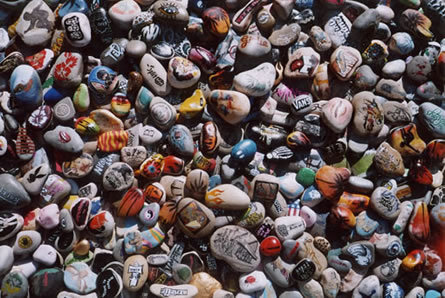Olivier Millagou
dal 5/7/2006 al 8/9/2006
Segnalato da
5/7/2006
Olivier Millagou
Galerie Erna Hecey, Bruxelles
Five summer stories. A tropical Hawaiian paradise. Paradise lost or regained? - such is the question posed by this exhibition, which examines with a quasi-ethnographic eye the land of Mai-Tais and surfing, hula-skirts and palm trees, breezy beach afternoons and twinkling midnight skies. Millagou presents 5 works reversing the cliche' of the sunny holiday spot.

Five summer stories
Aloha! Erna Hecey Gallery is pleased to welcome you to a tropical Hawaiian paradise as conceived and presented by the innovative French artist Olivier Millagou.
Paradise lost or paradise regained? - such is the question posed by this exhibition, which examines with a quasi-ethnographic eye the land of Mai-Tais and surfing, hula-skirts and palm trees, breezy beach afternoons and twinkling midnight skies. The volcanic archipelago, first inhabited by Polynesians settlers, entered into modern history with the expedition of Captain James Cook (who named them the Sandwich Islands in honor of his sponsor the Earl of Sandwich, inventor of the popular lunchtime comestible), and was later annexed as a territory of the United States in 1898, and granted statehood in 1959. The idyllic image of Hawaii - land of sea, sex, and sun - is belied by its violent history, marked by the subjugation of the local population at the hands of colonial forces. Today Hawaii offers the properly postmodern spectacle of traditional folk culture re-created for the benefit of ever-present tourists.
The title of the show is taken from the classic seventies movie Five Summer Stories, heralded by Surfer Magazine as “the finest surf movie ever made", “an incredible barrage of audio-visual stimulus".
Likewise, for his Hawaii exhibition Millagou presents five works. Reversing the cliche' of the sunny holiday spot, the white cube of the gallery is painted black and covered with white stars, the night being perhaps the only time when the islands really become the land of the Hawaiians, after the tourists have already been charmed by the beautiful sunset and retreated to their hotels and fancy bars. “Wouldn’t it be nice", from the famous song by the Beach Boys, is written in cursive iron letters and mounted on the wall, in the style of name plaques for vacation houses. Wall drawings, glowing under black lights, recreate scenes from post-cards showing the islands as the ideal holiday destination. Black palm trees offer a sharp contrast to the iconic image of the palm tree as sign of paradise, their somber shapes alluding instead to paradise lost. Finally, pebble beach takes up one corner of the gallery, each stone painted with a scene linked to surf culture, Polynesian themes, tiki, rock emblems, etc. A soundtrack for the show is provided by a series of 45’s ironically playing funeral music on a ukulele.
Olivier Millagou, born in 1974, lives and works in Bandol, France, a favorite seaside resort for the jet-set before the time of Brigitte Bardot and St. Tropez.
Go to Hawaii
(Hawaii) Hawaii (Hawaii)
Straight to Hawaii (Hawaii, Hawaii)
Oh do (Honolulu, Waikiki) you wanna come along with me
(Do you wanna come along with me)
Now I don’t know what town you’re from
But don't tell me that they got bigger waves
’Cause everyone that goes
Comes back with nothing but raves
That's in Hawaii...
(The Beach Boys)
Another solo show of Olivier Millagou, Surf Now Apocalypse Later, takes place on the French Riviera at the Galerie de la Tete d’Obsidienne, Fort Napole'on in La Seyne-sur-Mer, France, until the 29th of July.This summer, the artist is also participating in the group exhibition Giardino - Places For Small Stories in palazzo delle Arti di Napoli, Italy.
Image: PEBBLES, 2002 - 2006, pebble painting, installation of approx. 1450 pebbles
Opening Thursday 06 July 6.30 - 9 pm
Erna Hecey Gallery
rue Des Fabriques 1c 1000 Brussels
Tuesday to Saturday 2 - 7 pm



